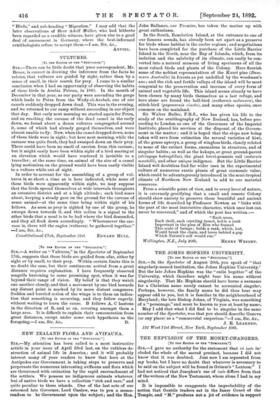[To THE EDITOR OF THE "SPECTATOR. "] SIR, —A writer on
"Vultures," in the Spectator of September 17th, suggests that these birds are guided from afar, either by sight or by smell, to their prey. Within certain limits this is no doubt the case, but their continuous arrival from a great distance requires explanation. I have frequently observed seagulls hastening to some promising spot, when it was far beyond their range of vision. My belief is that they watch one another closely, and that a movement by one bird towards any distant point is marked by its more distant congeners. Sudden and hurried action of the wings is to them an indica- tion that something is occurring, and they follow eagerly, without waiting to learn the cause. B follows A, C hastens in the direction of B, and so on, covering amongst them a large area. It is difficult to explain their concentration from great distances, except under some such hypothesis as the


































 Previous page
Previous page